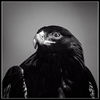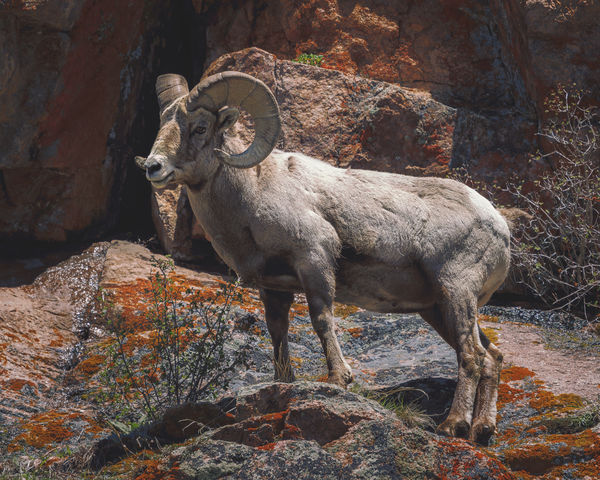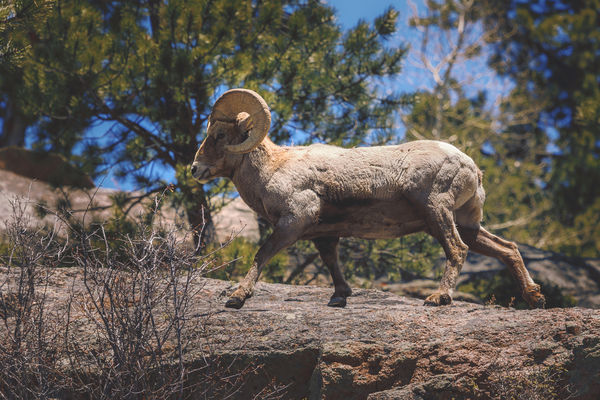Wildlife and harsh sunlight.
May 31, 2019 18:40:09 #
I've touched on this, before: If you want to photograph wildlife, you have to take the opportunities when and where they are presented. Wildlife searches do not always result in success, so you must be ready when you see something.
Once you see the animal, you don't usually have much opportunity to maneuver yourself into an advantageous lighting situation. Maybe you can do that, but prudence dictates that you take some shots while the animal is in sight, because the animal might not wait around while you are searching for a better vantage point. If you're lucky, you are on a perfect line, in between the animal and the sun. If you are even luckier, the sun will be somewhat low in the sky. If your days are like mine often are, not only will the very bright sun be high in the sky, but it will be immediately to the right of you. (Why is the right side so bad? If you are like most folks, you'll be looking through the viewfinder with your right eye. Your right hand will be on the shutter button and the aperture/shutter speed controls, unavailable to block the light that is blasting your peripheral vision, hampering your ability to get a good reading through the viewfinder. If the sun is high, left, it is still inconvenient, but not as bad.)
One animal I've been wanting to capture is a Bighorn Sheep ram that is old enough to have an impressive set of horns. I keep getting teenagers. Well, last week, I finally saw one that was worthy. Certainly, there are bigger horns out there, but I haven't seen them. The same conditions prevailed as with every other time I've encountered Bighorns. The sun is very bright, and high right. I also have to look up, to get the Bighorns. Combine this very harsh light with an animal that has white-ish fur, and you are facing a situation that can challenge the dynamic range of any camera. Normally, in a situation such as this, I'd bracket the shot, and use HDR to take care of the extremes. However, when your subject is a living -- and moving -- creature, having it hold still while you are taking your three shots is, frequently, too much to ask. So, all you can do is prevent blowout on the bright spots, and hope the shadows aren't so bad as to introduce noise, when you lighten them, in post.
It is certainly possible to produce a good result, if the shot was done in very harsh light, but it takes patience. You could achieve your desired result by dodging and burning, but, in the case of very harsh light, your patience may be tested. Luminosity masks are better at this, because they will allow you to exercise pinpoint control. (One step beyond luminosity masks is the approach used by Zone System Express, a product/training from Blake Rudis. This separates the photo into tonal zones, which is even more precise than luminosity masks.)
If the light was very harsh, even lightening/darkening with luminosity masks or zones may still leave you with trouble areas. You can only darken very bright areas so much. Soon, they start looking silvery gray, and that is no good. Here is where color grading can tame the beast. Sometimes, all you'll need is a sepia gradient, maybe using blend-if, if you wanted to leave the darker areas alone. There are all sorts of things you can do with color grading. (For some tutorials on color grading, go to youtube, and search for Blake Rudis. There are others, but he'll give you some free -- and useful -- tools.)
I'll include two, ram shots. These were unbelievably harsh, but I like the way they turned out.
Once you see the animal, you don't usually have much opportunity to maneuver yourself into an advantageous lighting situation. Maybe you can do that, but prudence dictates that you take some shots while the animal is in sight, because the animal might not wait around while you are searching for a better vantage point. If you're lucky, you are on a perfect line, in between the animal and the sun. If you are even luckier, the sun will be somewhat low in the sky. If your days are like mine often are, not only will the very bright sun be high in the sky, but it will be immediately to the right of you. (Why is the right side so bad? If you are like most folks, you'll be looking through the viewfinder with your right eye. Your right hand will be on the shutter button and the aperture/shutter speed controls, unavailable to block the light that is blasting your peripheral vision, hampering your ability to get a good reading through the viewfinder. If the sun is high, left, it is still inconvenient, but not as bad.)
One animal I've been wanting to capture is a Bighorn Sheep ram that is old enough to have an impressive set of horns. I keep getting teenagers. Well, last week, I finally saw one that was worthy. Certainly, there are bigger horns out there, but I haven't seen them. The same conditions prevailed as with every other time I've encountered Bighorns. The sun is very bright, and high right. I also have to look up, to get the Bighorns. Combine this very harsh light with an animal that has white-ish fur, and you are facing a situation that can challenge the dynamic range of any camera. Normally, in a situation such as this, I'd bracket the shot, and use HDR to take care of the extremes. However, when your subject is a living -- and moving -- creature, having it hold still while you are taking your three shots is, frequently, too much to ask. So, all you can do is prevent blowout on the bright spots, and hope the shadows aren't so bad as to introduce noise, when you lighten them, in post.
It is certainly possible to produce a good result, if the shot was done in very harsh light, but it takes patience. You could achieve your desired result by dodging and burning, but, in the case of very harsh light, your patience may be tested. Luminosity masks are better at this, because they will allow you to exercise pinpoint control. (One step beyond luminosity masks is the approach used by Zone System Express, a product/training from Blake Rudis. This separates the photo into tonal zones, which is even more precise than luminosity masks.)
If the light was very harsh, even lightening/darkening with luminosity masks or zones may still leave you with trouble areas. You can only darken very bright areas so much. Soon, they start looking silvery gray, and that is no good. Here is where color grading can tame the beast. Sometimes, all you'll need is a sepia gradient, maybe using blend-if, if you wanted to leave the darker areas alone. There are all sorts of things you can do with color grading. (For some tutorials on color grading, go to youtube, and search for Blake Rudis. There are others, but he'll give you some free -- and useful -- tools.)
I'll include two, ram shots. These were unbelievably harsh, but I like the way they turned out.
May 31, 2019 18:47:10 #
May 31, 2019 19:28:58 #
UTMike wrote:
Wonderful captures, Jim!
Thanks! It was a great day for wildlife -- elk, mule deer, Bighorns, moose, and even a bear.
Someone in my neighborhood reported a bear, on our street, about 3AM, rooting through someone's trash. I think I'm going to smear myself with bacon, and go out after dark, with just my camera. A friend says I should also bring a can of pepper spray, so the bear can properly season me. All for art.
Jun 1, 2019 07:55:02 #
Jun 1, 2019 07:59:27 #
Beautifully photographed and processed, Jim. I'm envious! Back around 2014/2015 I saw many elder statesmen, though most at great distance. Hope your selfie stick works with the bear 

Jun 1, 2019 10:16:02 #
jaymatt wrote:
Nice, especially the first one.
Thanks! I was pleased to get that pose. Most of the time, this fellow had his head behind a bush, or was taking off, as in the second shot.
Jun 1, 2019 10:19:21 #
Linda From Maine wrote:
Beautifully photographed and processed, Jim. I'm envious! Back around 2014/2015 I saw many elder statesmen, though most at great distance. Hope your selfie stick works with the bear 

Thanks! This is the oldest one I've seen. The Bighorns I've seen are often close enough to get a reasonable shot, but they've all been youngsters.
Jun 1, 2019 10:25:48 #
Anvil wrote:
I've touched on this, before: If you want to phot... (show quote)
I think they are very good
Jun 1, 2019 10:45:23 #
Jun 1, 2019 11:11:56 #
IMO, any shot you can get on these boys is a great capture. Unless they are on some sort of preserve they don't get old enough for those horns by being stupid. Again, IMO, any light sufficient to get the photo is good light. 

If you want to reply, then register here. Registration is free and your account is created instantly, so you can post right away.






